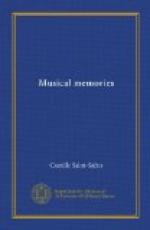Palestrina was the first to employ it in an anthem. Opinions differ on this, and certain students of harmony pretend that the chord which Palestrina used only has the appearance of the dominant seventh. I do not concur in this view. But however the case may be, the glory of unchaining the devil in music belongs to Montreverde. That was the beginning of modern music.
Later, a new third was superimposed and they dared the chord sol-si-re-fa-la. The inventor is unknown, but Beethoven seems to have been the first to make any considerable use of it. He used the chord in such a way that, in spite of its current use to-day, in his works it appears like something new and strange. This chord imposes its characteristics on the second motif of the first part of the Symphony in C minor. This is what gives such amazing charm to the long colloquy between the flute, the oboe and the clarinets, which always surprises and arouses the listener, in the andante of the same symphony. Fetis in his Traite d’Harmonie inveighed against this delightful passage. He admits that people like it, but, according to him, the author had no right to write it and the listener has no right to admire it. Scholars often have strange ideas.
Then Richard Wagner came along and the reign of the ninth dominant took the place of the seventh. That is what gives Tannhauser, and Lohengrin their exciting character, which is dear to those who demand in music above everything else the pleasure due to shocks to the nervous system. Imitators have fallen foul of this easy procedure, and with a laughable naivete imagine that in this way they can easily equal Wagner. And they have succeeded in making this valuable chord absolutely banal.
[Illustration: Jacques Offenbach]
By adding still another third we have the dominant eleventh. Offenbach used this, but it has played but a small part since then. Beyond that we cannot go, for a third more and we are back to the basic note, two octaves away.




